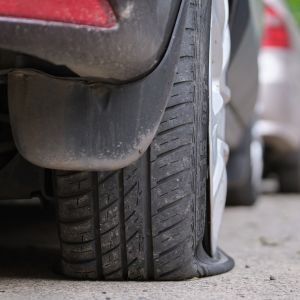Every driver’s nightmare is cruising down the road, only to be jolted by the realization that something may be amiss with their car. One of the most common and potentially hazardous issues is a punctured car tire. While the signs may not always be glaringly obvious, understanding the subtle cues can make all the difference in ensuring your safety and preventing further damage. Wondering how to tell if your car has a tire puncture? Learn the signs of a car puncture and what to do next in our latest blog post!
In this comprehensive guide, we’ll delve into the intricacies of identifying a car tire puncture, providing you with the knowledge to address the issue promptly and stay confidently in control of your vehicle.
The Unseen Culprit: Understanding Car Tire Punctures

Before we embark on the journey of detection, it’s crucial to comprehend what a car tyre puncture entails. Simply put, a car tire puncture occurs when an object, such as a nail or sharp objects, penetrates the tyre’s surface, causing air to escape. The gradual loss of tyre pressure can compromise your vehicle’s handling, fuel efficiency, and, most importantly, your safety on the road.
Visual Inspection: Eyes on the Tires

The first line of defense against a potential car tyre puncture is a visual inspection. Take a moment to thoroughly examine each car tyre. Look for any visible signs of damage, such as nails, screws, or sharp objects lodged in the tread. Additionally, inspect the sidewall for bulges, cuts, or other irregularities that could indicate a puncture. If you spot any foreign objects or anomalies, it’s a red flag that merits closer investigation.
Tactile Detection: The Hands-On Approach
Sometimes, the evidence of a puncture isn’t immediately visible. In such cases, a tactile approach can prove invaluable. Run your hands carefully over the surface of each car tire, feeling for any abnormalities. If you come across a sharp object or a protruding nail, exercise caution and avoid removing it yourself – this could lead to a sudden loss of air. Instead, mark the location and proceed to seek professional assistance from a tyre specialist.
Pressure Check: Monitoring the Vital Signs
A sudden drop in car tyre pressure is a telltale sign of a puncture. Most modern vehicles are equipped with a Tire Pressure Monitoring System (TPMS) that alerts drivers to significant pressure deviations. However, it’s wise to conduct manual pressure checks regularly, especially if you suspect a puncture. Use a reliable car tire pressure gauge to measure the air pressure in each tyre, comparing the values to the manufacturer’s recommended levels. A significant deviation may indicate a leak caused by a puncture.
Auditory Clues: Listening to Your Tires
Believe it or not, your sense of hearing can play a crucial role in detecting a car tyre puncture. While driving, pay attention to any unusual sounds emanating from your tyres. A persistent hissing or whistling noise may indicate air escaping from a punctured tyre. If you notice such sounds, it’s advisable to pull over safely and investigate the source promptly.
Water Test: Unveiling Subtle Leaks
Identifying slow leaks can be challenging, but a water test can help reveal subtle punctures. Mix a small amount of dish soap with water and apply the solution to the tire’s surface. Watch for bubbles forming at specific points – these bubbles signify air escaping and pinpoint the location of the puncture. This DIY method can be particularly useful for detecting minor leaks that might go unnoticed during routine inspections.
Prevention Measures: Safeguarding Your Tires

While knowing how to identify a car tire puncture is essential, taking preventive measures can significantly reduce the likelihood of encountering this issue. Keep your tires properly inflated, rotate them regularly, and invest in high-quality tires with strong puncture resistance. Avoid debris-laden roads when possible and be mindful of your driving habits, steering clear of sharp objects whenever feasible.
Conclusion: Empowering Drivers with Knowledge
In the realm of automotive maintenance, knowledge is undeniably power. Recognizing the signs of a tire puncture early on can save you from the inconvenience of roadside breakdowns and, more importantly, enhance your safety on the road. Regular inspections, coupled with a proactive approach to tire maintenance, will ensure that you stay in control of your vehicle, confidently navigating the highways and byways with peace of mind.
As you embark on your next journey, armed with the insights from this guide, remember that a vigilant eye and a keen ear can make all the difference in ensuring a smooth and secure ride. Whether you’ve experienced a car puncture or simply need to move a vehicle without putting it in neutral, towing without shifting gears can be done safely under certain conditions.

